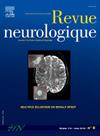Postural balance and visual dependence in patients with demyelinating neuropathies differ between acquired and hereditary etiologies
IF 2.3
4区 医学
Q2 CLINICAL NEUROLOGY
引用次数: 0
Abstract
Background
Demyelinating polyneuropathies affect posture and can be either hereditary, as in Charcot-Marie-Tooth type 1A (CMT1A), or autoimmune, as in chronic inflammatory demyelinating polyradiculoneuropathy (CIDP). Clinical differentiation between these two neuropathies can be challenging and biomarkers are lacking. No comparative analysis of their balance profiles has been conducted.
Methods
The postural balance of 23 patients with CIDP and 23 patients with CMT1A, matched for age, sex, and functional scores, were recorded using a force platform under various conditions. The effects of visual dependence were examined based on center of pressure velocity, 90% confidence ellipse area, and the Romberg quotient which represents the ratio between posturography with eyes closed and eyes open.
Results
With eyes open, the two groups exhibited similar area and velocity. They increased their postural sway when visual input was eliminated. Nevertheless, the increase in postural sway was less pronounced in CMT1A patients than in patients with CIDP, who then had a higher Romberg quotient.
Conclusion
Patients with CMT1A appear to have developed compensatory mechanisms over time resulting in reduced visual dependence. Further studies are necessary to explore other compensatory mechanisms of equilibrium that could be targeted by rehabilitation for patients with CIDP.
脱髓鞘神经病患者的姿势平衡和视觉依赖在获得性病因和遗传性病因之间存在差异。
背景:脱髓鞘性多发性神经病会影响姿势,既可能是遗传性的,如夏科-玛丽-牙1A型(CMT1A),也可能是自身免疫性的,如慢性炎症性脱髓鞘性多发性神经病(CIDP)。这两种神经病的临床鉴别具有挑战性,而且缺乏生物标记物。目前尚未对这两种神经病的平衡特征进行比较分析:方法:使用力平台记录了 23 名 CIDP 患者和 23 名 CMT1A 患者在不同条件下的姿势平衡情况。根据压力中心速度、90%置信椭圆面积和罗姆伯格商数(代表闭眼和睁眼时的体位测量比率)对视觉依赖性的影响进行了研究:结果:睁眼时,两组显示出相似的面积和速度。当视觉输入消失时,他们的姿势摇摆增加。然而,CMT1A 患者的姿势摇摆增加不如 CIDP 患者明显,后者的朗伯格商数更高:结论:随着时间的推移,CMT1A 患者似乎形成了代偿机制,从而降低了视觉依赖性。有必要开展进一步的研究,探索 CIDP 患者康复治疗可针对的其他平衡代偿机制。
本文章由计算机程序翻译,如有差异,请以英文原文为准。
求助全文
约1分钟内获得全文
求助全文
来源期刊

Revue neurologique
医学-临床神经学
CiteScore
4.80
自引率
0.00%
发文量
598
审稿时长
55 days
期刊介绍:
The first issue of the Revue Neurologique, featuring an original article by Jean-Martin Charcot, was published on February 28th, 1893. Six years later, the French Society of Neurology (SFN) adopted this journal as its official publication in the year of its foundation, 1899.
The Revue Neurologique was published throughout the 20th century without interruption and is indexed in all international databases (including Current Contents, Pubmed, Scopus). Ten annual issues provide original peer-reviewed clinical and research articles, and review articles giving up-to-date insights in all areas of neurology. The Revue Neurologique also publishes guidelines and recommendations.
The Revue Neurologique publishes original articles, brief reports, general reviews, editorials, and letters to the editor as well as correspondence concerning articles previously published in the journal in the correspondence column.
 求助内容:
求助内容: 应助结果提醒方式:
应助结果提醒方式:


